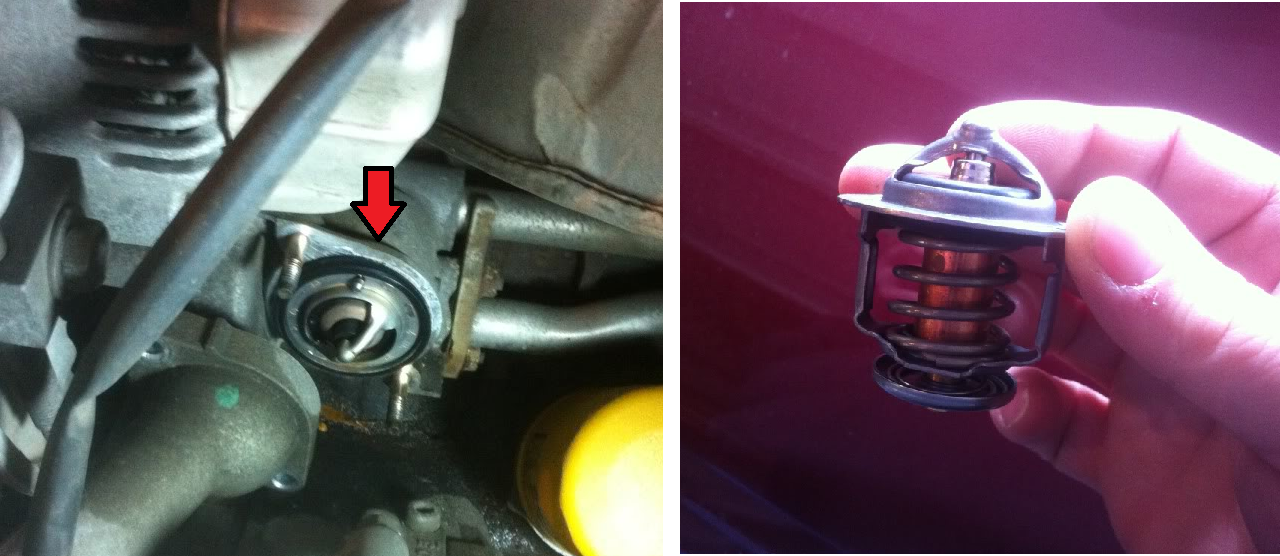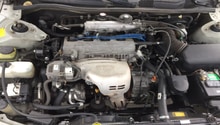Toyota Camry: Why is My Car Overheating?
An overheating engine is a stressful problem. Anxiety can build to an all time high watching your Camry's temperature gauge climb into the red as you are sitting in rush hour traffic. Save yourself the headache by diagnosing your overheating problem.
This article applies to the Toyota Camry (1997-2011).
Modern internal combustion engines are said to be only 30-35% efficient. While this number is on the rise and manufacturers like Toyota are leading the way in new technologies, one may wonder where the extra 70% percent of lost energy goes. The process of converting gasoline into mechanical energy has several by-products, one of which is thermal energy (heat). To keep an engine operating properly, the cooling system is constantly absorbing and releasing the heat energy to the atmosphere via the radiator. While the cooling system is not overly complex, any problems that arise will affect the cooling of the engine and potentially cause overheating. This article will outline several issues that may be causing an overheating issue on the Toyota Camry.

Materials Needed
- Digital multimeter
- Metric sockets and wrenches
- Ratchet and extension
- Distilled water
- Funnel
- Catch pan
- New coolant
Step 1 – Check coolant level
The first step to diagnosing an overheating car is to check the coolant level. Coolant circulates through the engine and absorbs heat via heat transfer. The hot coolant is then pumped through the radiator where it is cooled by passing air before being circulated back into the engine block. With a lack of coolant in the cooling system, insufficient heat will be pulled from the hot engine and overheating can occur. More often than not, owners find that topping up their coolant level goes a long way in keeping their car cool.
- With the engine cool, inspect the coolant level in the reservoir. If it is empty, remove the radiator cap and add coolant until full. With the radiator full, fill the reservoir to the cold fill line. Generally speaking, it is okay to top off the cooling system with distilled water; however, it is recommended to use a 50/50 coolant mix if the cooling system is extremely low.
- It is an opportune time to inspect the radiator cap while topping off the coolant level. The radiator cap keeps the cooling system under pressure thus raising the coolant boiling point. If the rubber gasket on the cap is hard, cracked, split, or completely missing, replace the cap.

Figure 1. Coolant level and radiator cap inspection.
Pro Tip
If you find that you are continuously having to top off the coolant level, it is likely that a coolant leak is present. Inspect all areas of the car for leaking coolant. Pay special attention to all hose connections, the timing belt area (bad water pump), and the radiator for traces of coolant.
Step 2 – Inspect coolant condition and radiator
In addition to checking the level of the coolant, inspect its general condition. Surprisingly, many vehicles on the road today have a neglected cooling system that can lead to a variety of cooling issues. The additives in coolant breakdown over time and cannot provide the necessary protection to prevent buildup in the cooling system. Similarly, filling with tap water or mixing different types of coolant can result in a sludge, rust, or scale buildup that can plug up the cooling system and cause the engine to overheat. The radiator is especially susceptible to becoming plugged as the coolant flows through very small passageways called cores. If there is abnormal buildup inside of the radiator, flush the cooling system immediately. If rust or scale has been at work inside the radiator for a long period of time, a commercially available cooling system flush product may be needed to help clean out the radiator. In severe cases, the plugged radiator may need to be replaced as the cores can be damaged.
(Related Article: How to Flush The Cooling System - CamryForums.com)

Pro Tips
- A severely plugged radiator is susceptible to leaking after a chemical flush. Do not choose a caustic flush solution as the chances of radiator or heater core damage are much higher. If the radiator leaks after flushing, radiator replacement is imminent.
- Inspect the front side of the vehicle and radiator for any obstruction (trash, bugs, etc.) that can reduce cooling efficiency.
Step 3 – Inspect cooling fans
The Camry uses electric cooling fans to help pull cool air through the radiator in instances when the car is not traveling at a fast enough speed for passing air to keep the water temperature down. If the cooling fan system fails, the car will often remain cool while moving but will usually begin to overheat when idling or in stop-and-go traffic. The electric fans should have a high and low speed function and should also operate when the air conditioner is switched on. In some models, the fans should come on with the ignition switch turned on and the fans unplugged from the coolant temperature switch.
Additionally, the fans can be unplugged and supplied 12 volts to test their operation. If the fans are functional, the problem likely lies in the coolant temperature switch or the fan relays. The temperature switch can be tested for continuity with a digital multimeter when the coolant heats up. A working temperature switch signals to the fans to run when the coolant temperature reaches a set temperature. Also, the fan relays can be swapped with a new or known good relay to restore functionality.
Either way, temperature switches and relays are inexpensive components that often fail, rendering the fans inoperable and leaving you with an overheating car. Fortunately, both components are fairly cheap and can be replaced without breaking the bank.

Featured Video: How to Test a ETC Switch
Step 4 – Check the thermostat
A higher-mileage Camry is prone to thermostat failure which would cause overheating problems. A thermostat is basically a valve that interrupts the flow of coolant through the engine when the car is cold. This lack of coolant flow allows for the engine to quickly reach operating temperature. As the coolant heats up, the thermostat will open to allow full flow of the coolant through the cooling system. Unfortunately, the thermostat can fail in either the open or closed position. An open thermostat will not allow the car to heat up properly. In winter months, the car may never reach full operating temperature. A stuck closed thermostat will cause overheating issues because the coolant cannot circulate through the engine.
In either case, the thermostat should be replaced. There is really no way to test a faulty thermostat besides removing it from the car. That being said, a thermostat can be quickly and easily replaced. In fact, many Camry owners will replace their thermostat every other time they flush the cooling system for peace of mind.

Pro Tip
If you have recently replaced your thermostat but are still experiencing overheating issues, the thermostat could be installed backwards or air pockets can trapped inside the cooling system.
Step 5 – Check the head gasket
If the components of the cooling system are in good shape and functional, the overheating issue may stem from a blown head gasket. While most components related to overheating issues are easily inspected, a blown head gasket is nearly undetectable from the outside of the engine. Unless the head gasket is visibly leaking on the outside of the engine, it is typically leaking into the combustion chamber. Coolant can be drawn into the combustion chamber and burned during the power stroke. During compression, hot exhaust gases can be pushed into the cooling system and cause overheating. Inspecting spark plugs can give a hint of a bad gasket as can inspecting each cylinder with a borescope. Unfortunately, replacing a blown head gasket requires the engine to be disassembled. However, before jumping to this conclusion, see if you have any of the following symptoms related to a blown head gasket:
- Engine overheating
- Loss of coolant without noticeable leaks
- White exhaust smoke
- Air bubbles in the radiator or overflow tank
- Coolant in engine oil (milky oil)
If several of these symptoms are present, your engine overheating issue is likely caused by a blown head gasket.

Related Discussions
- 1998 Camry Overheating - CamryForums.com
- 2003 Electric Fans Not Working - CamryForums.com
- Blown Head Gasket - CamryForums.com






